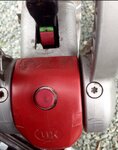- Apr 8, 2019
- 47
- 27
- 10,535
Hi
Just replaced the side friction pads on the alko stabiliser tow hitch and reading this article https://www.practicalcaravan.com/advice/how-to-change-clean-al-ko-aks-3004-stabiliser-pads post for the front and rear pads suggests:
'Look at the front of the stabiliser handle. If you see the green plastic segment below the red one (not the button on the front of the hitch), the front and rear pads are fine.
'However, if you see only the red segment, they are worn and new ones are needed.'
The problem I have, I can't see anything green other than the button and there isn't a photo to illustrate what they are refering to.
How do I know if the front and rear pads are warn and need replacing?
Just replaced the side friction pads on the alko stabiliser tow hitch and reading this article https://www.practicalcaravan.com/advice/how-to-change-clean-al-ko-aks-3004-stabiliser-pads post for the front and rear pads suggests:
'Look at the front of the stabiliser handle. If you see the green plastic segment below the red one (not the button on the front of the hitch), the front and rear pads are fine.
'However, if you see only the red segment, they are worn and new ones are needed.'
The problem I have, I can't see anything green other than the button and there isn't a photo to illustrate what they are refering to.
How do I know if the front and rear pads are warn and need replacing?


